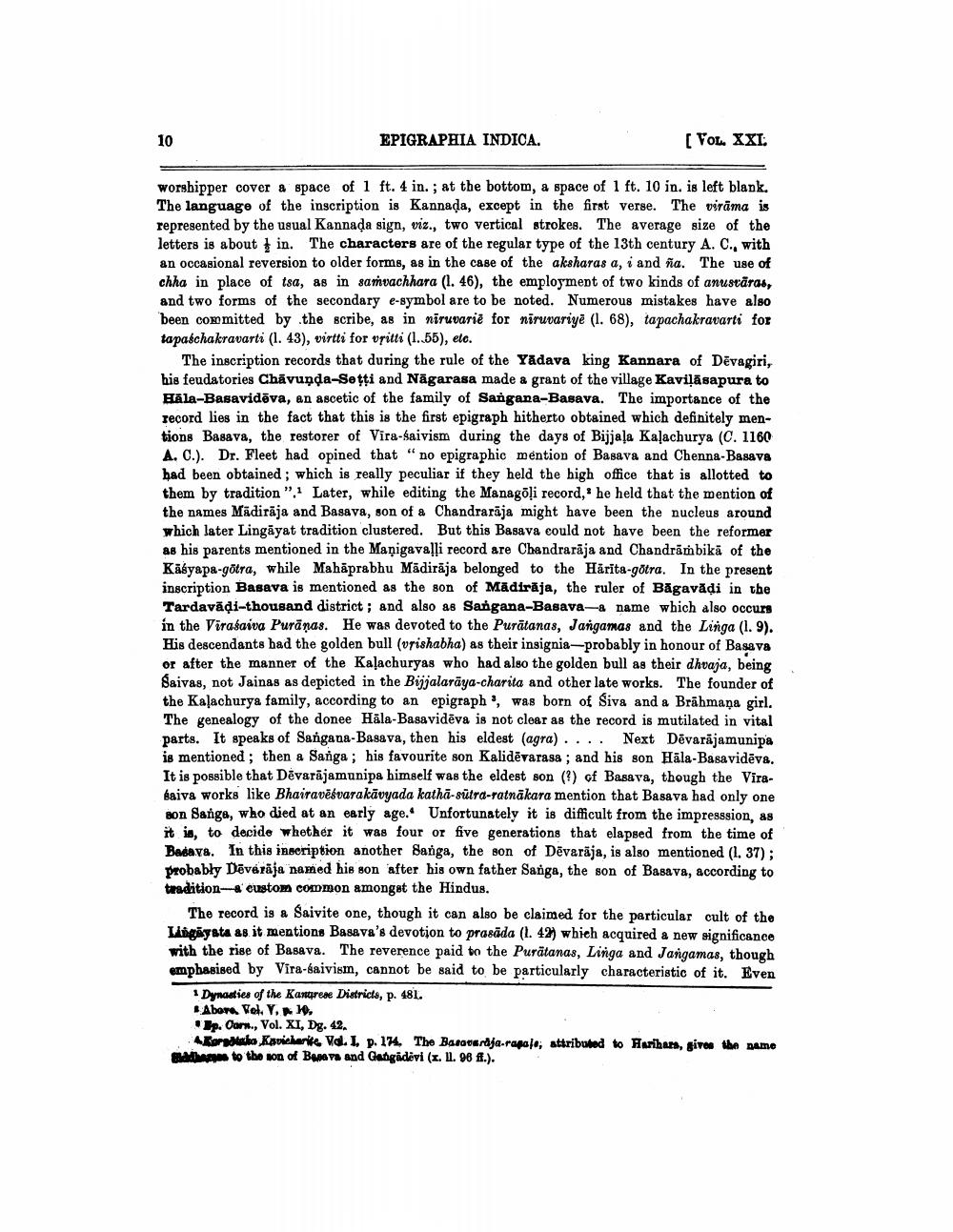________________
10
EPIGRAPHIA INDICA.
[FOL. XXI.
worshipper cover a space of 1 ft. 4 in.; at the bottom, a space of 1 ft. 10 in. is left blank. The language of the inscription is Kannada, except in the first verse. The virāma is represented by the usual Kannada sign, viz., two vertical strokes. The average size of the letters is about in. The characters are of the regular type of the 13th century A. C., with an occasional reversion to older forms, as in the case of the aksharas a, i and ña. The use of chha in place of tsa, as in samuachhara (l. 46), the employment of two kinds of anustāras, and two forms of the secondary e-symbol are to be noted. Numerous mistakes have also been committed by the scribe, as in niruvarie for niruvariye (1. 68), tapachakravarti for tapaschakravarti (1. 43), virtti for vritti (1.55), etc.
The inscription records that during the rule of the Yadava king Kannara of Dēvagiri, his feudatories Chāvunda-Setti and Nāgarasa made a grant of the village Kaviļāsapura to Hāla-Basavidēva, an ascetic of the family of Sangana-Basava. The importance of the record lies in the fact that this is the first epigraph hitherto obtained which definitely mentions Basava, the restorer of Vira-saivism during the days of Bijjaļa Kaļachurya (C. 1160 A. C.). Dr. Fleet had opined that "no epigraphic mention of Basava and Chenna-Basava had been obtained; which is really peculiar if they held the high office that is allotted to them by tradition".1 Later, while editing the Managāļi record, he held that the mention of the names Madirāja and Basava, son of a Chandrarāja might have been the nucleus around which later Lingāyat tradition clustered. But this Basava could not have been the reformer as his parents mentioned in the Manigavalli record are Chandrarāja and Chandrambikā of the Kābyapa-gotra, while Maháprabhu Mădirāja belonged to the Härita-gotra. In the present inscription Basava is mentioned as the son of Mādirāja, the ruler of Bāgavādi in the Tardavādi-thousand district; and also as Sangana-Basava- name which also occurs in the Virasaiva Puranas. He was devoted to the Purātanas, Jangamas and the Linga (1.9). His descendants had the golden bull (vrishabha) as their insignia-probably in honour of Basava or after the manner of the Kalachuryas who had also the golden bull as their dhuaja, being Saivas, not Jainas as depicted in the Bijjalarāya-charita and other late works. The founder of the Kaļachurya family, according to an epigraph, was born of Siva and a Brāhmaṇa girl. The genealogy of the donee Hāla-Basavidēva is not clear as the record is mutilated in vital parts. It speaks of Sangana-Basava, then his eldest (agra) ... Next Dēvarājamunipa is mentioned; then a Sanga ; his favourite son Kalidēvarasa; and his son Hāla-Basavidēvs. It is possible that Dévarājamunipa himself was the eldest son () of Basava, though the Virabaiva works like Bhairavēsvarakāvyada kathā-sütra-ratnākara mention that Basava had only one son Sanga, who died at an early age. Unfortunately it is difficult from the impresssion, as it is, to decide whether it was four or five generations that elapsed from the time of Basaya. In this inscription another Sanga, the son of Dēvarāja, is also mentioned (1.37); probably Dāvarāja named his son after his own father Sanga, the son of Basava, according to tradition- eustom common amongst the Hindus.
The record is a Saivite one, though it can also be claimed for the particular cult of the Ingriyata as it mentions Basava's devotion to prasāda (L. 42) which acquired a new significance with the rise of Basava. The reverence paid to the Purätanas, Linga and Jangamas, though emphasised by Vira-laivism, cannot be said to be particularly characteristic of it. Even
1 Dynasties of the Kantrese Districts, p. 481. *Aboro. Vol. V, 1,
Ip. Oorn., Vol. XI, Dg. 42
Forsiaho Kavishenke Vol. I, p. 174. The Bascoardja-rapale, attributed to Farihans, given the name Buddha to the son of Boara and Gangadovi (X. IL. 96 ff.).




